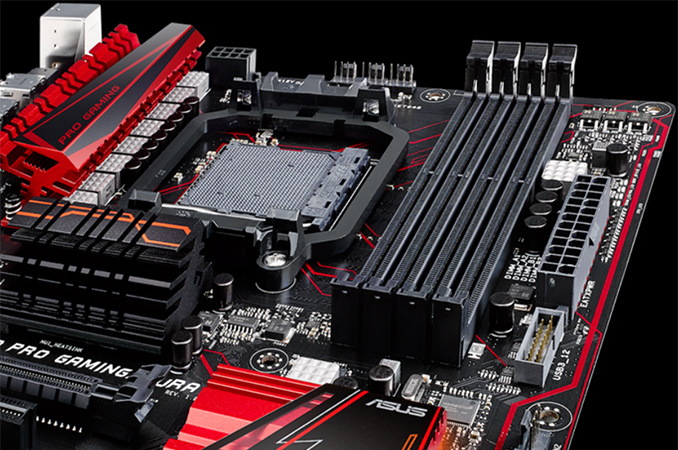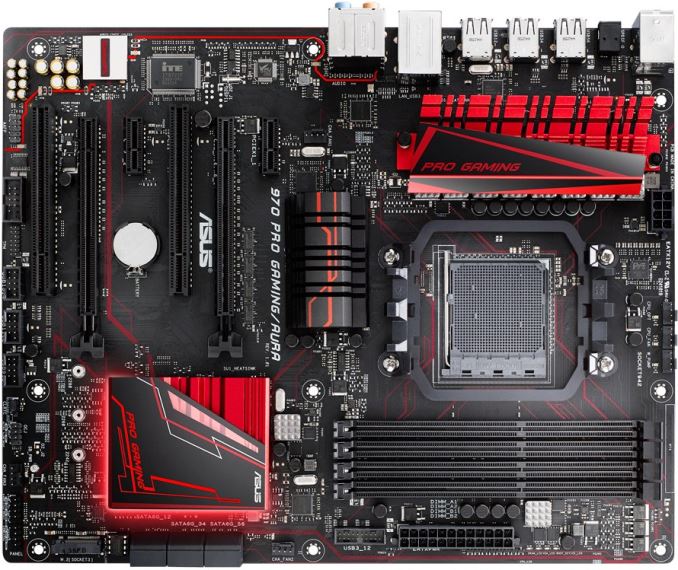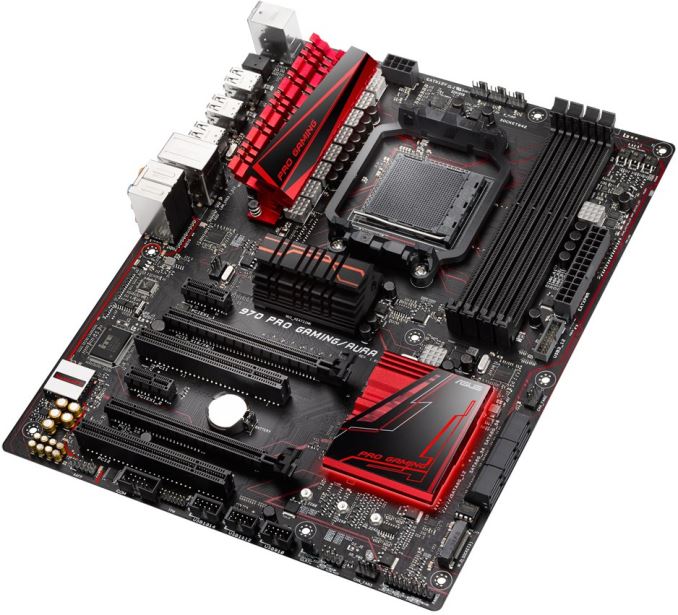ASUS Launches 970 Pro Gaming/Aura Motherboard: USB 3.1 and M.2 to AMD FX Platform
by Anton Shilov on February 2, 2016 1:00 PM EST
ASUS has introduced its latest motherboard for AMD FX microprocessors that brings up-to-date features to the platform. The ASUS 970 Pro Gaming/Aura belongs to a new class of AMD FX (socket AM3+) mainboards that support USB 3.1 peripherals as well as M.2 solid-state drives. In addition, the platform is also equipped with various gaming-oriented features available on the latest platforms from the company.
The ASUS 970 Pro Gaming/Aura is based on the AMD 970 + SB950 chipset, which is not AMD’s top-of-the-range core-logic for the FX processors, but which is pretty affordable for mainstream motherboards. The AMD 970 did not officially support any multi-GPU technology when it was released five years ago. AMD has removed this limitation since then and modern AMD 970-based mainboards, such as the 970 Pro Gaming/Aura, can run more than one video card. The motherboard has two PCI Express slots for graphics cards operating in PCIe 2.0 x8 mode and officially supporting both AMD CrossFire and NVIDIA SLI. In addition, the new mainboard features two PCIe 2.0 x1 and two PCI slots for add-in cards.
| AMD 900 Series Chipsets | |||
| 990FX + SB950 | 990X + SB950 | 970 + SB950 | |
| Code Name | RD990 | RD980 | RX980 |
| Released | Q2 2011 | Q2 2011 | Q2 2011 |
| PCIe Lanes | 42 PCIe 2.0 lanes | 26 PCIe 2.0 lanes | 26 PCIe 2.0 lanes |
| CrossFire | x16 + x16 x8 + x8 + x8 + x8 |
x8 + x8 | x16 + x4 x8 + x8 + x4 |
| SLI | x16 + x16 x16 + x8 + x8 x8 + x8 + x8 + x8 |
x8 + x8 | x8 + x8 |
| NB TDP | 19.6W | 14W | 13.6W |
| HyperTransport (MHz) | 2600 | 2600 | 2400 |
| SATA 6 Gb/s | 6 | 6 | 6 |
| RAID | 0, 1, 5, 10 | 0, 1, 5, 10 | 0, 1, 5, 10 |
| USB 2.0 | 14 | 14 | 14 |
| PCI | Yes | Yes | Yes |
| SB950 TDP | 6W | 6W | 6W |
The ASUS 970 Pro Gaming/Aura supports all AMD FX processors in AM3+ form-factor with up to 125W TDP as well as their predecessors, such as the Phenom II, the Athlon II and the Sempron 100-series chips (but advised against using the 220W FX-9000 series). The new motherboard has upgraded 8-phase power delivery and similar to other ASUS designs the 970 Pro Gaming/Aura uses the company’s Digi+ custom power controller. The motherboard features four memory slots and supports up to 32 GB of DDR3-2133 memory.
The 970 Pro Gaming/Aura comes with six SATA 6 Gb/s ports with RAID 0, 1, 5 and 10 support as well as an M.2 slot for SSDs (2242/2260/2280 form-factors are supported) that operates in PCIe 2.0 x4 mode and supports data-rates of up to 20 GT/s, making it suitable for drives such as the Samsung XP941. The UEFI/BIOS of the motherboard fully supports NVMe protocol and therefore the platform can take advantage of modern SSDs, such as Samsung 950 Pro. However it is unclear whether the M.2 slot uses PCIe lanes from the AMD970 or the SB950 controller. The platform also comes bundled with RAMcache software to speed up launches of frequently used applications.
Meanwhile for USB functionality the motherboard is equipped with ASMedia’s ASM1142 USB 3.1 controller that enables two USB 3.1 type-A connectors on the rear panel. In addition, the mainboard supports two USB 3.0 ports (also using an ASMedia controller) and 14 USB 2.0 ports.
For other functionality we get Intel's I211-AT Gigabit Ethernet controller with the GameFirst software for network traffic prioritization as well as LANGuard ESD and power surge protection. Audio comes through ASUS' SupremeFX, their upgraded Realtek ALC1150 codec solution, with EM shielding, PCB separation of analog/digital signal and support for up to 300 ohms headphones.
The motherboard is designed for low-cost gaming systems, though that hasn't stopped ASUS from adding a set of overclocking features into its BIOS and the components necessary to drive it. The aim is to get a full system price that is competitive. For example, the AMD FX-8320 featuring four Piledriver modules and unlocked multiplier can be purchased for $145, which is comparable to the price of Intel’s dual-core Core i3 processors. Once overclocked, the FX-8320 chip can offer rather decent performance for its price (see our results of the FX-8370E overclocked to 4.8 GHz here). The mainboard also supports AMD CrossFireX, NVIDIA SLI, as well as USB 3.1 and M.2/NVMe, which should attract attention of people seeking for the latest technologies and an easy upgrade path (at least, for graphics).
As an added flair for users that are interested, the ASUS 970 Pro Gaming/Aura also features Aura RGB LED on the south bridge, which can produce various lighting effects, such as pulsating, strobing, fading and so on. The motherboard is clearly not the first affordable platform to offer LED lighting, but ASUS just had to include the technology into the package simply because a number of competing offerings come with LEDs. They can also be switched off if needed.
The ASUS 970 Pro Gaming/Aura has not yet reached retailers, however Newegg already has a listing up for $119.99.
Source: ASUS













25 Comments
View All Comments
gammaray - Wednesday, February 3, 2016 - link
whats the point of this mobo when they have the 990fx chipset available?JesseKramer - Wednesday, February 3, 2016 - link
Just had a look at the comparison between the 8320E @ 4.8 GHz and i7 990X @ Stock.http://anandtech.com/bench/product/1403?vs=444
An interesting set of data points for those of us still of x58 platforms, especially now that all those cheap hex core Xeons are floating around.
Compared to the AM3+ FX, X58, a platform that arrived in 2008 mind you, Has 40 PCIe 2.0 lanes and more compute capability across the board, even before overclocking is taken into account.
USB 3.1 and M.2/NVMe are really the only features that are missing. And much of that functionality can be added via PCIe cards.
Vive la X58
extide - Wednesday, February 3, 2016 - link
Its 36+8 lanes. X79 moved to 40 lanes.bill.rookard - Wednesday, February 3, 2016 - link
It's nice to see they're updating the platform in some respects, but they're still flogging what amounts to a dead horse. While they're still iterating on the CPU side of things, the inherent limitations with the FX series of chips in regards to IPC and thermals mean that it'll be gone shortly.Considering the Phenom II hex cores are as powerful as the FX-8xxx chips, it shows that they haven't really moved forward in years. When Zen is released, hopefully two things will happen:
1) They'll be competitive with Intel.
2) AM3 will finally be relegated to support status only.
extide - Wednesday, February 3, 2016 - link
Well, #2 is guaranteed to happen, AMD has said it want to move to just the AM4 and FP4 sockets.MrCommunistGen - Wednesday, February 3, 2016 - link
Since it's 2016 it feels silly debating CPUs released in late 2010 and late 2012 (respectively) I'd say that the FX-83xx chips do generally outperform the Phenom II X6 chips.http://anandtech.com/bench/product/203?vs=697
Sure it isn't across the board, there are a few outliers where the FX chip severely underperforms the X6, but for the majority of the tests the FX is either tied or significantly ahead of the X6.
legolasyiu - Wednesday, February 3, 2016 - link
I wonder if this motherboard can achieve overclock above 9Ghz, because of 8 phrase and better voltages regulators than Asus Crosshair V Formula-ZNotmyusualid - Wednesday, February 3, 2016 - link
Quote: I'm confused as to which is the article and which is the comment... :)Hil-friken-larious man.
Thanks for the first good laugh of the day.
top1234 - Thursday, February 4, 2016 - link
Download Games Free Full Version: http://th3gamesfull.blogspot.com/BrokenCrayons - Friday, February 5, 2016 - link
I'm not sure I understand the point of a premium motherboard targeted at gaming for current AMD processors. Why put on an elaborate and showy dress with a non-competitive foundation beneath? AMD CPUs are excellent low-budget chips that can keep total hardware costs down when compared to Intel processors if the buyer is willing to sacrifice a little compute power and deal with the higher heat/noise output so paring such a chip with the unnecessary cost of an expensive motherboard seems a bit contrarian. For something that's going to be buried under all the other innards inside a computer case, balancing cost and quality rather than focusing solely on styling seems more prudent in getting the right mix of components.